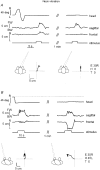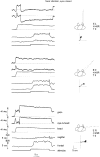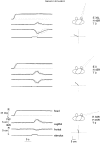Effect of gaze on postural responses to neck proprioceptive and vestibular stimulation in humans
- PMID: 10432359
- PMCID: PMC2269485
- DOI: 10.1111/j.1469-7793.1999.0301o.x
Effect of gaze on postural responses to neck proprioceptive and vestibular stimulation in humans
Erratum in
- J Physiol (Lond) 1999 Sep 15;519 Pt 3:923
Abstract
1. We studied the effect of gaze orientation on postural responses evoked by vibration of neck dorsal muscles or by galvanic stimulation of the vestibular system during quiet standing in healthy humans. Various gaze orientations were obtained by different combinations of horizontal head-on-feet (-90, -45, 0, 45, 90 deg) and eye-in-orbit (-30, 0, 30 deg) positions. The instantaneous centre of foot pressure was recorded with a force platform. 2. With a symmetrical position of the vibrator relative to the spine, neck muscle vibration elicited a body sway in the direction of the head naso-occipital axis when the eyes were aligned with it. The same result was obtained both during head rotations and when the head and trunk were rotated together. 3. For lateral eye deviations, the direction of the body sway was aligned with gaze orientation. The effect of gaze was present both with eyes open and eyes closed. After long-lasting (1 min) lateral fixation of the target the effect of gaze decreased significantly. 4. Postural responses to galvanic vestibular stimulation tended to occur orthogonal to the head naso-occipital axis (towards the anodal ear) but in eight of the 11 subjects the responses were also biased by the direction of gaze. 5. The prominent effect of gaze in reorienting automatic postural reactions indicates that both neck proprioceptive and vestibular stimuli are processed in the context of visual control of posture. The results point out the importance of a viewer-centred frame of reference for processing multisensory information.
Figures







References
-
- Andersen RA, Snyder LH, Bradley DC, Xing J. Multimodal representation of space in the posterior parietal cortex and its use in planning movements. Annual Review of Neuroscience. 1997;20:303–330. - PubMed
-
- Baldenweck L. Leçons sur L'Exploration de L'Appareil Vestibulaire. Paris: Vigot Frères; 1927.
-
- Berthoz A. The role of gaze in compensation of vestibular disfunction: the gaze substitution hypothesis. Progress in Brain Research. 1988;76:411–420. - PubMed
-
- Berthoz A. Reference frames for the perception and control of movement. In: Paillard J, editor. Brain and Space. New York: Oxford University Press; 1991. pp. 81–111.
-
- Bianconi R, van der Meulen JP. The response to vibration of the end organ of mammalian muscle spindles. Journal of Neurophysiology. 1963;26:177–190. - PubMed
Publication types
MeSH terms
LinkOut - more resources
Full Text Sources
Other Literature Sources
Medical

